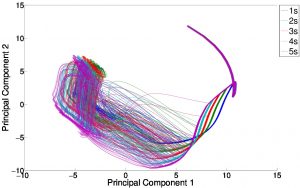Studying the origins of learning and memory using neuroevolution
Memory and learning are two of the cornerstones of our cognition. Without learning, organisms would be restricted to the behaviors described by their genetic code. This can pose a problem when the environment they are born in is not entirely predictable. With learning, organisms can acquire new skills and increase their chances of survival and of reproduction by fully exploiting their surroundings.
The current trend in research on learning and memory focuses on synapses. Since the discovery that experiences modify synapses, every memory present in the brain has been studied within that framework. But if we look at the origins of life and the advantages provided by learning in the everyday life of an organism, it is not implausible that other mechanisms for learning were present before the appearance of plastic synapses. For instance, an early example of learning without synapses can be seen the slime mold Physarum Polycephalum. Without having a brain, this organism can measure the duration between two stimuli, memorise it and predict its next appearance. Its ability originates from the complex internal dynamics of the chemicals composing it.
In my work, I am interested in finding out if learning mechanisms similar to the ones found in Physarum Polycephalum can exist in the brain, albeit using the interactions between neurons instead of chemicals. To that end, in my previous research, I used artificial neural networks to model the brain, and tuned their parameters using evolutionary algorithms to complete tasks requiring specific learning abilities to be completed.
My research during my visit at ELSI focuses on the origins of time perception and symbolic memories. During my previous work, I evolved neural networks without synaptic plasticity that were capable of memorising symbolic information. The memory was stored inside a fixed attractor, or in its attractor basin. In another research, I applied the same methodology to study the origins of time perception and discovered that the memory could also be stored in different trajectories within the dynamical landscape of the network (see figure 1). These two phenomena require learning and memory, but the dynamics that evolved in both research differed greatly. This made me wonder what kind of mechanism would evolve if a task requires symbolic memory and time perception to be completed. Maybe both mechanisms would exist in different neural modules, or one would evolve faster and the second would rely on the neural systems evolved for the first, or if a single mechanism can implement everything. I setup a evolutionary robotic experiment to find out which of the choices it could be. My goal is that at the end of this experiment I will have a better understanding of how early mechanisms for learning and memory evolved, and how they might have interacted.
